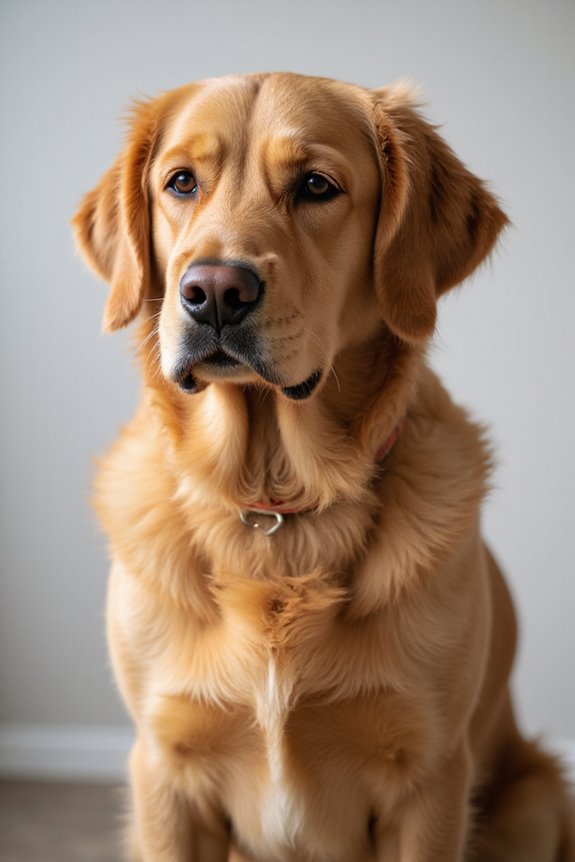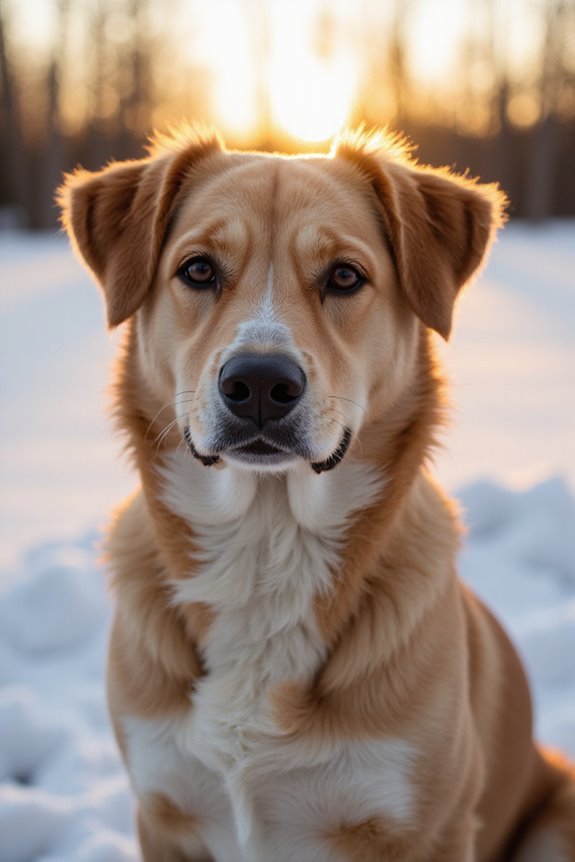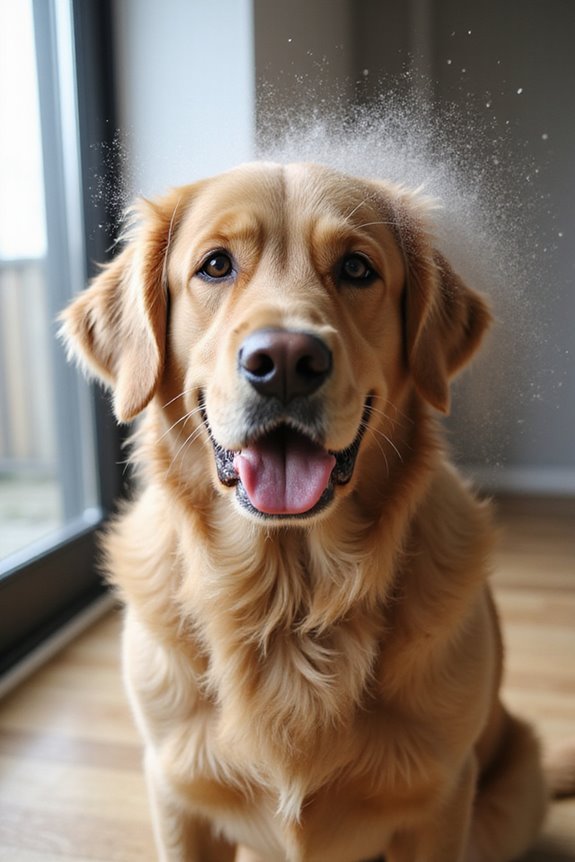To treat dog hot spots effectively, I recommend starting with proper identification of the issue. Begin by trimming the hair around the lesion, then clean it with a mild antiseptic solution. After that, apply treatments like hydrocortisone cream for inflammation or antibiotic ointment to prevent infection. If symptoms worsen or persist beyond 24 hours, seeking veterinary assistance is essential. Maintaining an environment free of irritants and incorporating prevention strategies will support your dog’s skin health. You’ll find additional insights on long-term care.
Key Takeaways
- Clip the hair around the hotspot for better air circulation and easier cleaning.
- Clean the area with mild antiseptic solutions using dampened gauze to minimize discomfort.
- Apply hydrocortisone cream to reduce inflammation and a triple antibiotic ointment for infection prevention.
- Keep the area dry and consider using desiccating sprays to promote healing.
- Monitor your dog for worsening symptoms or prolonged hotspots, and consult a veterinarian if needed.
Identifying Hot Spots
When trying to identify hot spots on your dog, it’s essential to understand both their appearance and the behavioral signs that accompany them. Symptom recognition starts with observing the skin. Hot spots often manifest as small, red, irritated patches on specific hot spot locations—primarily the head, legs, and hips. These areas may also suffer from hair loss or crusting.
Behaviorally, your dog might excessively lick, chew, or rub the affected area, showing clear signs of discomfort.
To summarize key identification factors:
- Red, swollen patches
- Hair loss around lesions
- Fluid or scabbing
- Foul odor
Acting promptly can prevent the situation from escalating and guarantee your dog feels more comfortable.
Initial Care and Cleaning
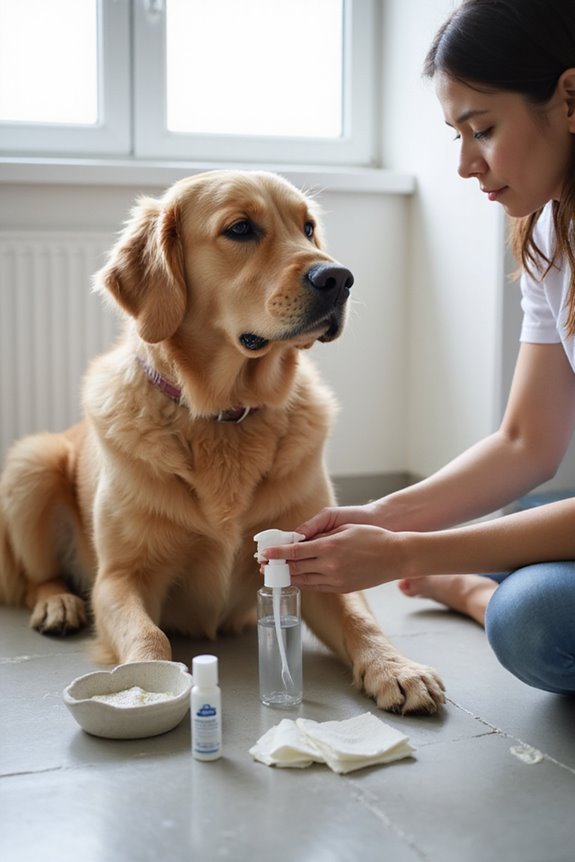
To effectively manage a hot spot on your dog, proper initial care and cleaning are essential steps. Start with an initial assessment; carefully clip the hair around the lesion to enhance air circulation and reduce moisture. This can be painful, so sedation may be needed for some dogs. Use gentle cleaning techniques, applying a mild antiseptic solution like chlorhexidine with dampened gauze. Make sure to dab rather than wipe to prevent further discomfort. Avoid antiseptics with alcohol, as they cause irritation. Remember to keep the area dry, allowing it to air out and using recommended desiccating agents if needed. By taking these careful steps, you’ll promote healing while minimizing trauma to your dog’s sensitive skin.
Topical Treatments
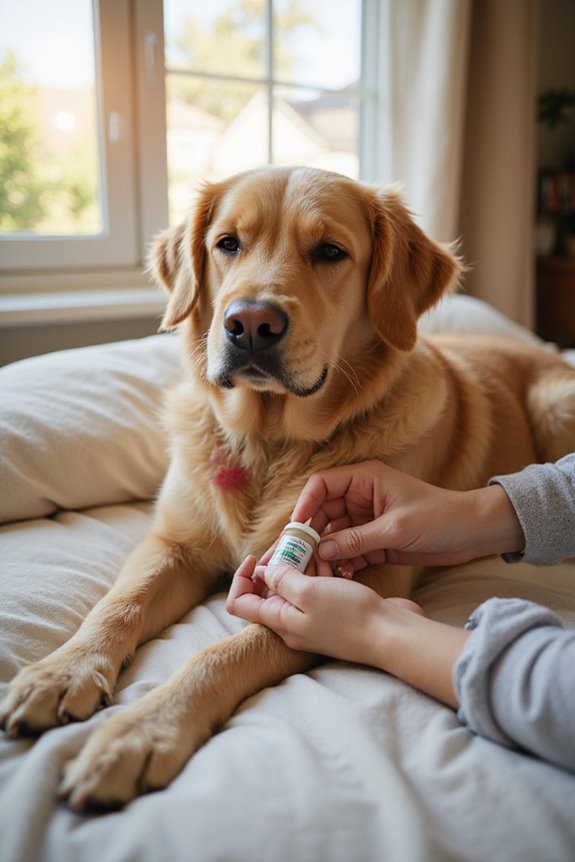
Topical treatments play an essential role in managing dog hot spots, as they can particularly alleviate symptoms and promote healing. I’ve found that several effective topical applications can help soothe your pet’s discomfort:
- Hydrocortisone Cream: This can reduce inflammation and is often a go-to from the human first-aid shelf.
- Triple Antibiotic Ointment: Brands like Neosporin can safely prevent infection with small applications.
- Pramoxine Products: Ideal for dogs that can’t tolerate steroids, these provide temporary pain relief.
- Desiccating Sprays: Perfect for drying moist lesions, promoting quicker healing.
- Soothing Agents: Options like aloe vera gel can cool the skin and reduce inflammation.
When to Seek Veterinary Help
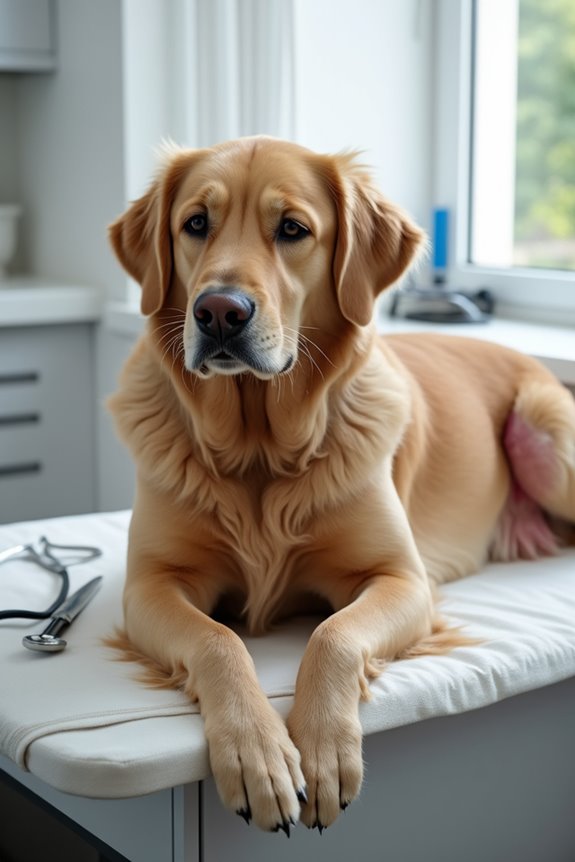
Recognizing the right moments to seek veterinary help for your dog’s hot spots is essential for effective management and healing. You should consider immediate intervention if:
- The itching intensifies beyond mild irritation.
- You notice oozing, pus, or moist inflamed areas—these suggest possible infection.
- There are noticeable patches of hair loss around the hotspot, indicating a worsening condition.
- Hotspots persist for more than 24 hours, which often points to infection.
- Your dog displays pain or aggressive reactions when you touch the area.
Additionally, recurrent hotspots might reveal underlying causes like chronic allergies or parasitic infestations that require professional assessment. Don’t hesitate to consult your veterinarian if home treatments aren’t effective, as they can provide a tailored approach to your dog’s needs.
Monitoring the Healing Process
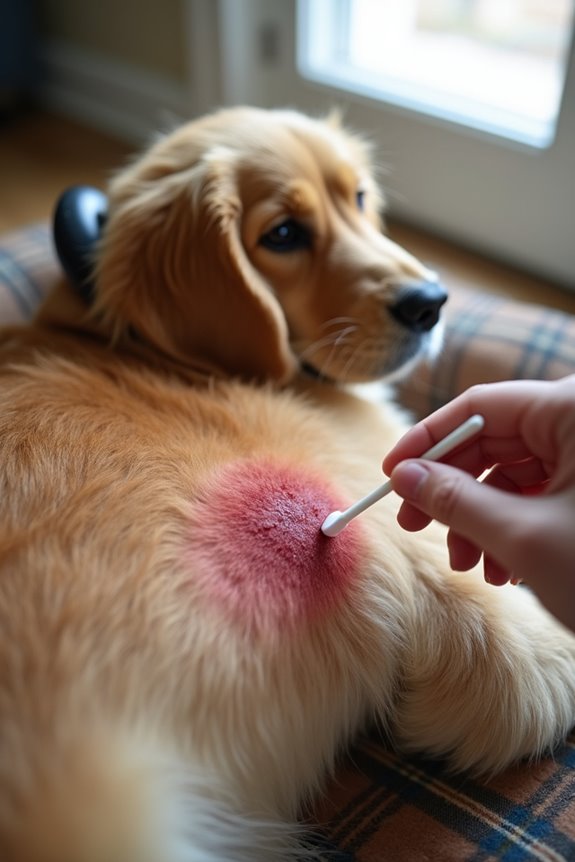
Monitoring the healing process of your dog’s hot spots is essential for ensuring a swift recovery. I recommend daily inspections to observe any recovery signs. Within 2 to 3 days, you should expect to see initial improvements, such as reduced redness and oozing. As the healing timeline progresses, the hot spot will soften and change color, ideally becoming pale pink. Take consistent photographs to track changes, and keep a log of symptoms like itchiness and comfort levels. Regularly measure the size of the lesion; a reduction indicates healing. Watch for signs of infection if swelling or redness persists, as this may require veterinary attention. Finally, keep the area clean to support the recovery process.
Prevention Strategies
Preventing hot spots in dogs requires a proactive approach that addresses grooming, parasite control, allergy management, environmental factors, and prompt skin care. Here are some effective strategies I’ve found helpful:
- Grooming Techniques: Regular brushing removes loose fur and debris, minimizing skin irritation, especially for long-haired breeds. Bathing with a mild, dog-friendly shampoo maintains skin hygiene, and clipping fur around vulnerable areas allows for better air circulation.
- Diet Adjustments: Identifying food allergies is essential; consider hypoallergenic diets to avoid triggers.
- Parasite Control: Consistently using flea preventatives and checking for ticks can help reduce irritation.
- Environmental Care: Keep living spaces clean and dry, while ensuring your dog has access to fresh water. Additionally, consider incorporating supplements that promote joint health to support overall well-being, as some dogs may develop hot spots due to discomfort from joint pain.
Home Remedies and Their Cautions
When it comes to treating hot spots in dogs, utilizing home remedies can be an effective approach, especially in the early stages of the condition. Here are some natural alternatives and topical applications that may help:
- Mild antiseptic sprays (like chlorhexidine) can clean the area, reducing infection risk.
- Coconut oil provides moisture while soothing inflamed skin.
- Apple cider vinegar diluted with water acts as a natural repellent; avoid open wounds to prevent stinging.
- Aloe vera gel soothes irritation when used cautiously to prevent licking.
Always monitor the hot spot for changes, and avoid letting your dog lick the area. If irritation worsens or symptoms persist, discontinue use and seek veterinary advice promptly for effective treatment.
Long-Term Skin Care for Dogs
Skin Nutrition
- Offer a complete, balanced diet rich in high-quality proteins like chicken or fish.
- Incorporate essential fatty acids and vitamins, particularly Vitamin E and B complexes, known for their moisturizing properties.
- Guarantee proper hydration to support skin elasticity.
- Consider integrating joint supplements that may also benefit skin health through anti-inflammatory properties.
Grooming Techniques
- Brush medium- and long-haired dogs daily to enhance blood circulation and distribute natural oils, while short-haired breeds should be brushed weekly.
- Use appropriate grooming tools based on coat type to remove dirt and allergens.
- Regular inspection during grooming helps identify early signs of irritation, promoting timely intervention.
Frequently Asked Questions
How Long Does It Take for Hot Spots to Heal?
I understand you’re curious about the healing process. In my experience, recovery time for hot spots can take anywhere from 7 to 10 days, with noticeable improvement around the first week. Patience really helps!
Can Hot Spots Spread to Other Pets?
I’ve learned that hot spot transmission isn’t common between pets. But with proper pet hygiene, like avoiding contact and keeping things clean, we can minimize risks. Always check with your vet for peace of mind.
Are Certain Dog Breeds More Prone to Hot Spots?
I’ve noticed that certain dog breeds are definitely more prone to hot spots. Understanding dog breed susceptibility helps in hot spot prevention, so I always make sure to keep my furry friend well-groomed and dry!
What Is the Cost of Veterinary Treatment for Hot Spots?
They say an ounce of prevention is worth a pound of cure; veterinary expenses for hot spots vary based on treatment options. I’d suggest planning ahead to manage those unexpected costs, so your pup stays happy!
Can Dietary Changes Help Prevent Hot Spots?
I’ve found that dietary changes, like adding supplements with omega-3s, can really help manage skin allergies. It’s amazing how a nutritious diet can nourish their skin and prevent those pesky hot spots from recurring.

